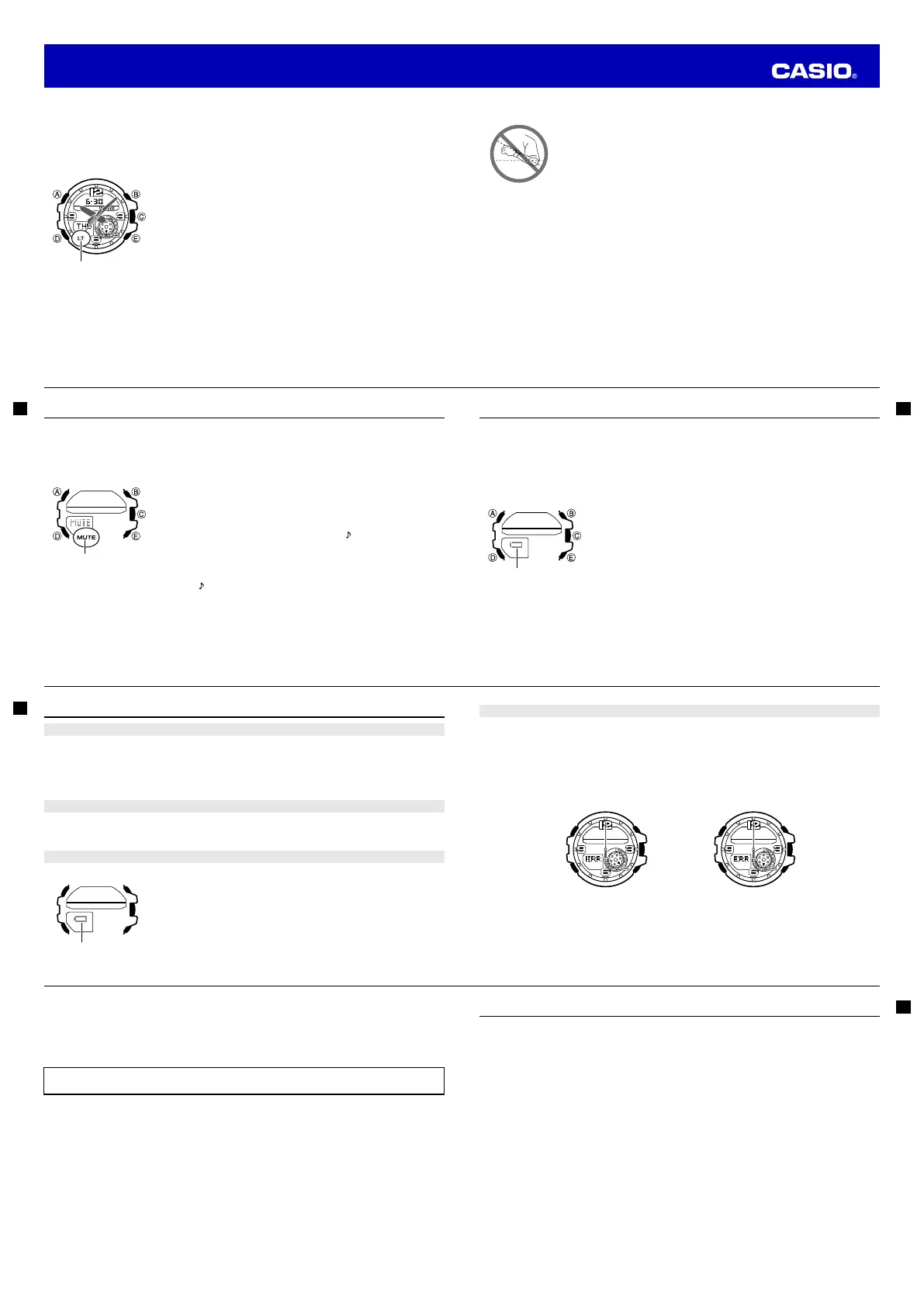E-48
Note
• Auto light is always disabled, regardless of its enabled/disabled setting, when any one of the following
conditions exists.
While an alarm is sounding
While the watch is in the Digital Compass Mode
To enable or disable auto light
In the Timekeeping Mode, hold down
B
for about three seconds to
toggle auto light between enabled (
LT
shown on the lower display) and
disabled (
LT
not displayed).
• The auto light enabled indicator (
LT
) is on the lower display in all
modes while auto light is enabled.
• Auto light remains enabled for about six hours. After that it becomes
disabled automatically.
Illumination Precautions
• Illumination may be hard to see when viewed under direct sunlight.
• Illumination turns off automatically whenever an alarm sounds.
• Frequent use of illumination runs down the battery.
Auto light enabled
indicator
E-49
Auto light precautions
• Illumination may not turn on if the face of the watch is more than 15
degrees above or below parallel. Make sure that the back of your hand
is parallel to the ground.
• Illumination turns off after the preset illumination duration (page E-46), even
if you keep the watch pointed towards your face.
• Static electricity or magnetic force can interfere with proper operation
of auto light. If illumination does not turn on, try moving the watch back
to the starting position (parallel with the ground) and then tilt it back
towards your face again. If this does not work, drop your arm all the
way down so it hangs at your side, and then bring it back up again.
• You may notice a very faint clicking sound coming from the watch
when it is shaken back and forth. This sound is caused by mechanical
operation of auto light, and does not indicate a problem with the watch.
E-50
Button Operation Tone
When enabled, the button operation tone sounds any time you press one of the watch's buttons. You can
enable or disable the button operation tone as desired.
• Even if you disable the button operation tone, the alarm, Hourly Time Signal, and Countdown Timer
Mode alarm all operate normally.
To enable or disable the button operation tone
1. In the Timekeeping Mode, hold down
A
until
ADJ
appears in the
lower display.
• When you release
A
(after ADJ appears), SET will be fl ashing in
the upper display.
2. Use
D
to cycle through settings on the lower display until the current
button operation tone setting (
MUTE
or
KEY
) is shown.
• See the sequence in step 2 of the procedure under “To change the
current time and date settings” (page E-15) for information about how
to scroll through setting screens.
3. Press
E
to toggle the button operation tone setting between enabled
(
KEY
) and disabled (
MUTE
).
4. After the setting is the way you want, press
A
to exit the setting
screen.
Note
• The mute indicator is displayed in all modes when the button
operation tone is disabled.
Mute indicator
E-51
Low Battery Indication
A low battery indicator appears on the display when the power of the batteries is low. Have the batteries
replaced as soon as possible.
Note
• For guidelines covering the life of the batteries and supported battery types, see “Specifi cations”
(page E-55).
The conditions below are in effect while the low battery indicator is fl ashing.
• All hands are stopped.
• Except for the low battery indicator, all other display functions are
disabled.
• Watch tones are disabled.
• Display illumination is disabled.
• Watch operations are disabled.
Note
• Sequentially or repeatedly performing sensor, light, alarm, and other power intensive operations
over a short period can cause a sudden drop in battery power, which will make the low battery
indicator fl ash. Even though the low battery indicator may disappear and watch functions may
become re-enabled, battery replacement is recommended.
Low battery indicator
E-52
Troubleshooting
Time Setting
■
The current time setting is off by a couple of hours.
Your Home City setting may be wrong (page E-13). Check your Home City setting and correct it, if necessary.
■
The current time setting is off by one hour.
You may need to change your Home City’s standard time/daylight saving time (DST) setting. Use the
procedure under “To change the current time and date settings” (page E-15).
World Time Mode
■
The time for my World Time City is off in the World Time Mode.
This could be due to incorrect switching between standard time and daylight saving time.
See “To confi gure World Time City and summer time settings” (page E-36) for more information.
Batteries
■
The low battery indicator is fl ashing on the digital display.
The watch’s battery power is low. Have the batteries replaced as soon as
possible.
See “Low Battery Indication” (page E-51).
Low battery indicator
E-53
Direction and Temperature Readings
■
The temperature unit setting won’t change.
The temperature unit setting is always Celsius (
°C
) whenever
TOKYO
is selected as the Home City. In
this case, the setting cannot be changed.
■
“ERR” appears while a sensor operation is in progress.
Subjecting the watch to strong impact can cause sensor malfunction or improper contact of internal
circuitry. When this happens,
ERR
(error) will appear on the display and sensor operations will be
disabled.
Digital Compass Operation Temperature Measurement
• If
ERR
appears while a measurement operation is being performed in a sensor mode, restart the
measurement. If
ERR
appears on the display again, it can mean there is something wrong with the
sensor.
• If
ERR
keeps appearing during measurement, it could mean there is a problem with the applicable
sensor.
E-54
■
“ERR” appears on the display following bidirectional calibration.
If
- -
appears and then changes to
ERR
(error) on the calibration screen, it means that there is something
wrong with the sensor.
• If
ERR
disappears after about one second, try performing the calibration again.
• If
ERR
keeps appearing, contact your original dealer or nearest authorized CASIO distributor to have
the watch checked.
Whenever you have a sensor malfunction, take the watch to your original dealer or nearest authorized
CASIO distributor as soon as possible.
■
Incorrect direction readings.
• Incorrect bidirectional calibration. Perform bidirectional calibration (page E-24).
• Nearby source of strong magnetism, such as a household appliance, a large steel bridge, a steel
beam, overhead wires, etc., or an attempt to perform direction measurement on a train, boat, etc. Move
away from large metal objects and try again.
■
Different results produced by direction readings taken at the same location.
Magnetism generated by nearby high-tension wires is interfering with detection of terrestrial magnetism.
Move away from the high-tension wires and try again.
■
Problems taking direction readings indoors.
A TV, personal computer, speakers, or some other object is interfering with terrestrial magnetism
readings. Move away from the object causing the interference or take the direction reading outdoors.
Indoor direction readings are particularly diffi cult inside ferro-concrete structures.
Remember that you will not be able to take direction readings inside of trains, airplanes, etc.
E-55
Specifi cations
Accuracy at normal temperature:
±15 seconds a month
Digital Timekeeping:
Hour, minutes, seconds, p.m. (P), month, day, day of the week
Time format: 12-hour and 24-hour
Calendar system: Full Auto-calendar pre-programmed from the year 2000 to 2099
Other: Home City code (can be assigned one of 48 city codes); standard time / daylight saving time
(summer time)
Analog Timekeeping:
Hour, minutes (hand moves every 10 seconds), seconds
Digital Compass:
20 seconds continuous readings; 16 directions; Angle value 0° to 359°; Hand indication of
north; Calibration (bidirectional); Magnetic declination correction; Bearing Memory
Thermometer:
Measurement and display range: –10.0 to 60.0°C (or 14.0 to 140.0°F)
Display unit: 0.1°C (or 0.2°F)
Measurement timing: Every fi ve seconds in the Thermometer Mode
Other: Calibration; Selectable measurement unit
Bearing Sensor Precision:
Direction: Within ±15°
Values are guaranteed for a temperature range of –10°C to 40°C (14°F to 104°F).
North indicated by second hand: Error within ±20°.
Temperature Sensor Precision:
±2°C (±3.6°F) in range of –10°C to 60°C (14.0°F to 140.0°F)
World Time:
48 cities (31 time zones)
Other: daylight saving time/standard time
Operation Guide 5476

